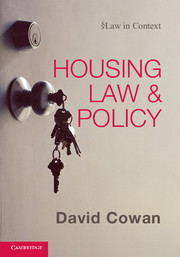Part II - Access to housing
Published online by Cambridge University Press: 05 June 2012
Summary
Introduction to Part II
It is a common mantra that social housing is allocated according to need while private sector housing is allocated according to affordability. Such assumptions underline much government thinking on allocation of social housing – even though, as we shall see, the government has shifted its thinking, relying to a greater extent on ‘choice’ in the process; nevertheless choice is balanced against need. However, one of the themes of this part of the book is that these concepts are far too blunt as evaluative tools to explain and justify actual practice(s) as well as the legislation involved in many cases. Indeed, we do not need to draw up sophisticated analytical, jurisprudential, or any other theoretical interpretation of these concepts. Rather, although it might surprise the reader, we find that the law and policy combine often to deny allocation according to need whereas the market (as well as government’s influence in it) distorts the notion of allocation according to affordability. In fact, when we talk about need and affordability, we are employing a set of values which themselves flesh out the principles involved. These values are political, historical, economic, class and ‘race’-based, as well as spatial, and provide the basis upon which tenure choice is made.
- Type
- Chapter
- Information
- Housing Law and Policy , pp. 141 - 144Publisher: Cambridge University PressPrint publication year: 2011

